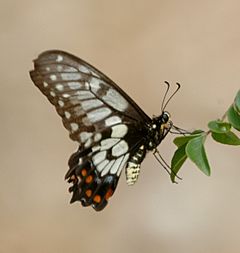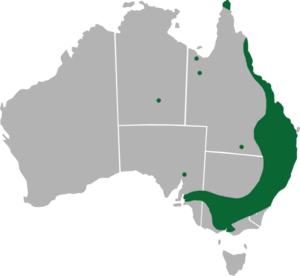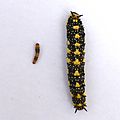Dainty swallowtail facts for kids
Quick facts for kids Dainty swallowtail |
|
|---|---|
 |
|
| Scientific classification | |
| Kingdom: | |
| Phylum: | |
| Class: | |
| Order: | |
| Family: | |
| Genus: |
Papilio
|
| Species: |
P. anactus
|
| Binomial name | |
| Papilio anactus Macleay, 1826
|
|
 |
|
| Range of Papilio anactus | |
| Synonyms | |
|
|
The Papilio anactus is a cool butterfly also known as the Dainty Swallowtail or Small Citrus Butterfly. It's a medium-sized butterfly that lives only in Australia.
This butterfly has a clever trick to stay safe from predators. Even though it's not poisonous itself, it looks a lot like the male Cressida cressida butterfly. The Cressida cressida is poisonous because of the plants its caterpillars eat, like the Dutchman's pipe. By looking similar, the Dainty Swallowtail fools predators into thinking it's dangerous too!
Contents
Where the Dainty Swallowtail Lives
The Papilio anactus butterfly is special because it's found only in Australia. It used to live mainly in New South Wales, Victoria, and Queensland.
However, in the late 1920s, farmers started growing many citrus trees. These trees are the perfect food for the butterfly's caterpillars! Because of this new food source, the butterflies spread to South Australia.
You won't find this butterfly on Kangaroo Island or in other parts of Australia. This is because there aren't enough citrus trees in those areas for them to thrive. Sometimes, you might also spot them in New Caledonia. They might have flown there, or perhaps they were introduced by people.
The Butterfly's Life Cycle
Like many butterflies, the Dainty Swallowtail goes through several amazing stages. It starts as an egg, then becomes a larva (caterpillar), then a pupa, and finally, a beautiful adult butterfly.
Egg Stage
The eggs of the Dainty Swallowtail are quite big and round. They are a pale yellow color when first laid. As the tiny caterpillar inside gets ready to hatch, the egg changes to an orange color.
Female butterflies are very picky about where they lay their eggs. They only choose fresh, new leaves on citrus plants. The eggs are usually laid on the edge of larger leaves, sometimes on top and sometimes underneath.
The caterpillars start growing inside the egg right after it's laid. Usually, the eggs hatch in about 3 or 4 days. However, this time can change depending on the weather. Small predators sometimes eat the eggs, and tiny wasps can also lay their own eggs inside them.
Larva (Caterpillar) Stage
When the caterpillar first hatches, it's dark and has two rows of short, spiky hairs. Its head is black, and the front part of its body has wide yellowish bands. These first few stages (called instars) look similar.
As the caterpillar grows, it changes. Later on, it develops a white upside-down 'V' shape on its head. This 'V' becomes very clear in its final caterpillar stage. The spiky hairs also become less noticeable as it gets bigger.
After hatching, the young caterpillar eats its own eggshell! Then, it starts munching on new leaf shoots. Older caterpillars prefer fully grown new leaves, but usually not the very old ones. In warm places, caterpillars go through five growth stages. In colder areas, they might have six stages before turning into a pupa.
A full-grown caterpillar is about 35 millimeters long. It's usually black with rows of fleshy black spikes along its back. It also has rows of large orange or yellow spots on its sides. You might see many small light blue and white spots too. The yellow and orange colors can vary a lot, and sometimes the orange might even be missing. Its head is large and black, with that distinctive white upside-down 'V'.
When a caterpillar feels threatened, it has a secret weapon! It can pop out a reddish-orange, Y-shaped organ called an osmeterium from behind its head. This organ releases a strong, citrusy smell, like rotting oranges. This smell is a warning to predators. The caterpillar tries to flick its head towards the attacker to make sure the smelly chemical hits them. This chemical is usually a type of irritant called butyric acid. Caterpillars have this special defense at all stages of their growth.
Pupa Stage
The pupa, also called a chrysalis, is straight and about 30 millimeters long. The part where its head would be sticks out noticeably. It's usually attached to the stems of the host plant. Interestingly, it often attaches on the opposite side of the tree from where the caterpillar was last eating. Sometimes, the caterpillar will even leave the plant to find a good spot to pupate.
The pupa is held in place by a silken thread around its middle. It can hang vertically or be held horizontally. The pupa's color can be either green or grey-brown, with different markings. This color helps it blend in perfectly with the stem it's attached to, making it look like a broken branch. If the stem is green or surrounded by leaves, the pupa will usually be green.
The time a butterfly spends as a pupa can vary. In summer, it might be only two weeks. In autumn, it could be up to four weeks. Many pupae formed in autumn will wait until the next spring to become adults. Some can even stay in this stage for 1 to 2 years, a process called diapause!
-
First (left) and last (right) instars of the caterpillar
Images for kids





